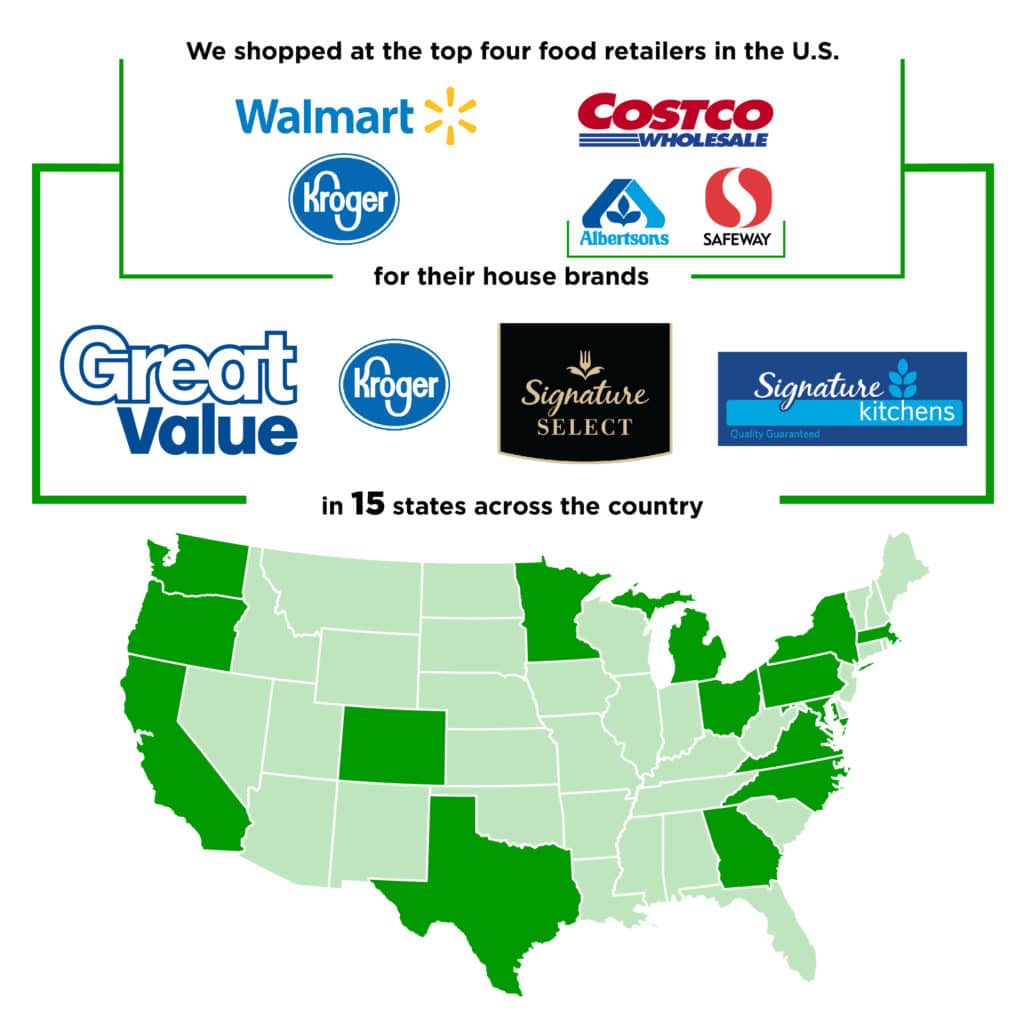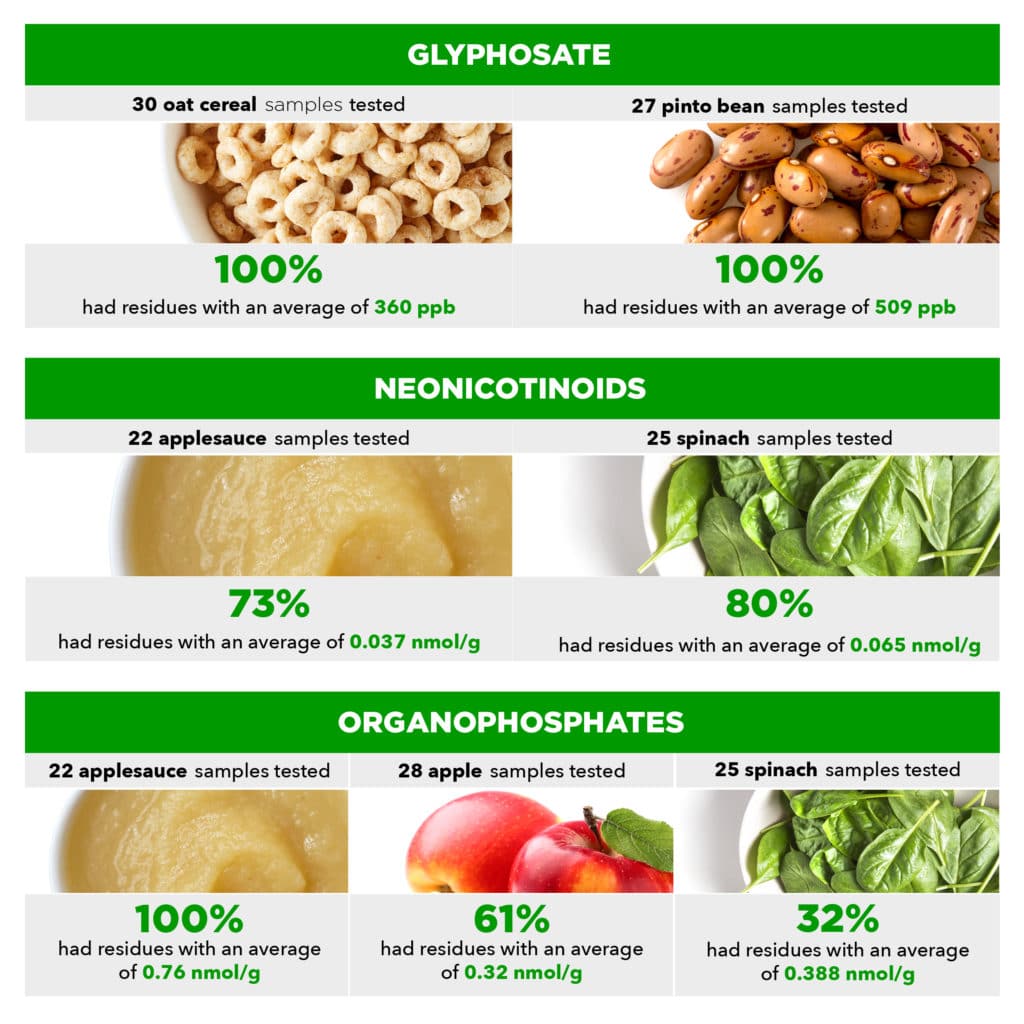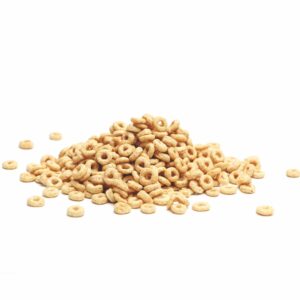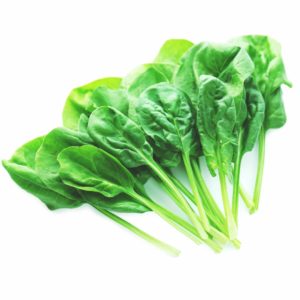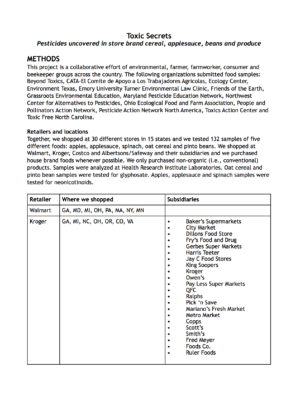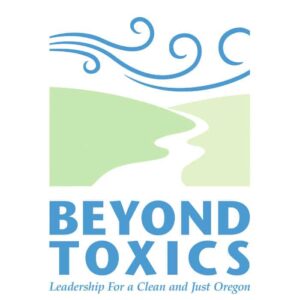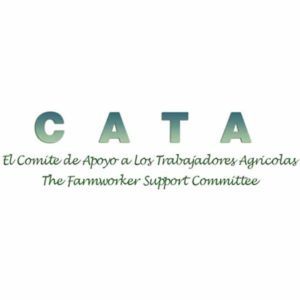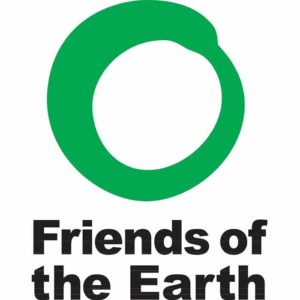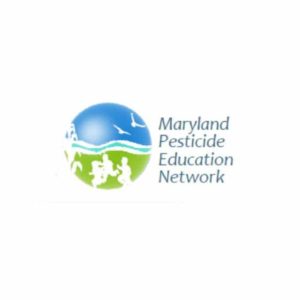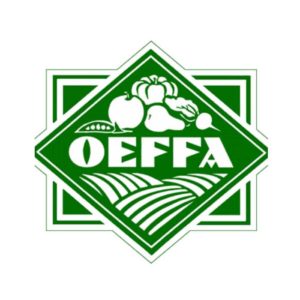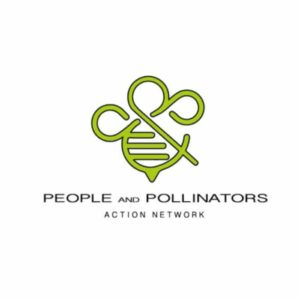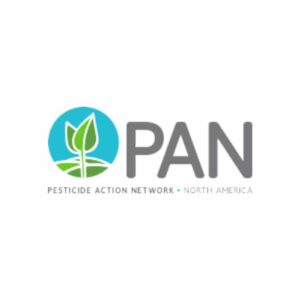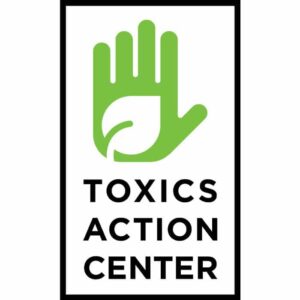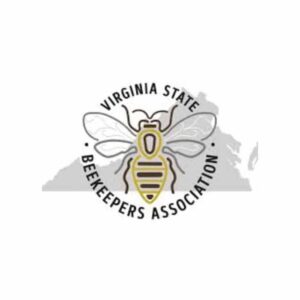Toxic Secret
Pesticides uncovered in store brand cereal, beans, produce
When most of us do our grocery shopping, we don’t suspect that the food we buy contains residues of toxic pesticides. But thousands of synthetic pesticides are allowed in non-organic agriculture in the U.S., and many of those most commonly used are linked to a range of health problems, from autism and infertility to cancer and Parkinson’s disease. Pesticide residues on food have increased since 2010, according to data released by the U.S. Food and Drug Administration.
At the same time, these pesticides are harming our environment. They pollute our soil and water. And they’re also wiping out bees, butterflies and other species critical to food production and healthy ecosystems. Friends of the Earth and our allies across the country conducted this testing to discover if pesticide residues are present in foods commonly eaten by children and families found at the top four food retailers in the United States: Walmart, Kroger, Costco and Albertsons/Safeway. Together, we tested 132 samples from over 30 stores across the country.
We tested the food at an independent lab and found residues of glyphosate, neonicotinoid and organophosphate pesticides.
Explore the results:
Glyphosate
We found residues of glyphosate, the active ingredient in Roundup herbicide. Glyphosate is a probable human carcinogen and is linked to high rates of non-Hodgkin’s lymphoma in farmers and groundskeepers. It is also associated with DNA damage, endocrine disruption and shortened pregnancy. In the environment, use of glyphosate is decimating Monarch butterfly populations by destroying the milkweed plants their young depend on.
We compared glyphosate residue levels we measured in cereal and pinto beans to Environmental Working Group’s (EWG) health-based benchmark. EWG determined that a one-in-a-million excess lifetime cancer risk for children would be posed by ingesting 0.01 milligrams of glyphosate per day. To reach this dose level, one would have to eat a single 60-gram serving of oat cereal with a glyphosate level of 160 ppb or a 90-gram serving of pinto beans with a glyphosate level of 110 ppb. The average glyphosate residue level we found on oat cereal (360 ppb) is more than twice the amount required to meet this benchmark, and the average level on pinto beans (509 ppb) is more than 4.5 times EWG’s cancer risk benchmark for children.
Oat Cereal
| Store | Brand | Range of Results (ppb) | Average (ppb) | % of Samples With Detected Residue | # of Samples Tested |
|---|---|---|---|---|---|
| Walmart | Walmart Great Value O's | 5 to 931 | 158 | 100% | 8 |
| Kroger | Kroger Toasted Oats | 18 to 720 | 483 | 100% | 7 |
| Costco Wholesale | Cheerios | 150 to 755 | 312 | 100% | 7 |
| Albertsons/Safeway | Albertsons/Safeway Signature Kitchens Toasted Oats | 284 to 826 | 497 | 100% | 8 |
Dry, Uncooked Pinto Beans
| Store | Brand | Range of Results (ppb) | Average (ppb) | % of Samples With Detected Residue | # of Samples Tested |
|---|---|---|---|---|---|
| Walmart | Walmart Great Value | 58 to 1,128 | 505 | 100% | 7 |
| Kroger | Kroger | 166 to 1,002 | 504 | 100% | 7 |
| Costco Wholesale | C&F Foods | 7 to 253 | 111 | 100% | 5 |
| Albertsons/Safeway | Albertsons/Safeway Signature Select | 36 to 1,849 | 802 | 100% | 7 |
Neonicotinoids
We found residues of neonicotinoids, which are associated with endocrine disruption and may affect the developing fetus and child, possibly leading to changes in behavior and attention, including an association with autism spectrum disorder. Neonicotinoids are also a key driver of massive pollinator losses, and scientists now warn of a second “Silent Spring” due to declines in insect and bird populations linked to increasing use of these insecticides.
Applesauce
| Store | Brand | Range of Results (nmol/g) | Average (nmol/g) | % of Samples With Residue | # of Samples Tested |
|---|---|---|---|---|---|
| Walmart | Walmart Great Value | ND to 0.038 | 0.019 | 63% | 8 |
| Kroger | Kroger | ND to 0.12 | 0.054 | 80% | 5 |
| Costco Wholesale | USDA Organic: 6 out of 7 Costco locations we shopped at offered only organic applesauce. | ||||
| Albertsons/Safeway | Albertsons/Safeway Signature Select | ND to 0.042 | 0.039 | 75% | 8 |
Results for Acetamiprid, Clothianidin and Imidacloprid.
Additional applesauce results can be found here.
Spinach
| Store | Brand | Range of Results (nmol/g) | Average (nmol/g) | % of Samples With Residue | # of Samples Tested |
|---|---|---|---|---|---|
| Walmart | Walmart Great Value | 0.019 to 0.37 | 0.14 | 100% | 5 |
| Kroger | Kroger | ND to 0.038 | 0.022 | 80% | 5 |
| Costco Wholesale | Boskovich, Green Gate Fresh and Taylor Farms | ND to 0.13 | 0.034 | 33% | 6 |
| Albertsons/Safeway | Fresh Express | ND to 0.27 | 0.065 | 88% | 8 |
Results for Clothianidin and Imidacloprid
Additional spinach results can be found here.
Organophosphates
We found residues of a class of pesticides called organophosphates, which are so toxic to children’s developing brains, even at extremely low levels of exposure, that scientists have called for a complete ban. They are associated with reduced IQ, attention disorders, delayed motor development, increased risk of learning disabilities, autism spectrum disorder, Alzheimer’s, Parkinson’s, hormone disruption and cancer. Organophosphates are also toxic to wildlife, including pollinators, birds and aquatic organisms.
Apples
| Store | Brand | Range of Results (nmol/g) | Average (nmol/g) | % of Samples with Residue | # of Samples Tested |
|---|---|---|---|---|---|
| Walmart | Walmart Great Value | ND to 1.14 | 0.44 | 50% | 8 |
| Kroger | Kroger | ND to 1.45 | 0.50 | 71% | 7 |
| Costco Wholesale | Loose apples | ND to 0.084 | 0.036 | 50% | 7 |
| Albertsons/Safeway | Albertsons/Safeway Signature Farms | ND to 1.26 | 0.31 | 71% | 6 |
Results for total DAPs metabolites
Applesauce
| Store | Brand | Range of Results (nmol/g) | Average (nmol/g) | % of Samples with Residue | # of Samples Tested |
|---|---|---|---|---|---|
| Walmart | Walmart Great Value | 0.11 to 3.23 | 0.79 | 100% | 8 |
| Kroger | Kroger | 0.28 to 1.15 | 0.67 | 100% | 5 |
| Costco Wholesale | USDA Organic: 6 out of 7 Costco locations we shopped at offered only organic applesauce | ||||
| Albertsons/Safeway | Albertsons/Safeway Signature Select | 0.05 to 3.31 | 0.83 | 100% | 8 |
Spinach
| Store | Brand | Range of Results (nmol/g) | Average (nmol/g) | % of Samples with Residue | # of Samples Tested |
|---|---|---|---|---|---|
| Walmart | Walmart Great Value | ND to 1.02 | 0.34 | 60% | 5 |
| Kroger | Kroger | ND to 0.054 | 0.022 | 40% | 5 |
| Costco Wholesale | Boskovich, Green Gate Fresh and Taylor Farms | ND to 0.073 | 0.026 | 50% | 6 |
| Albertsons/Safeway | Fresh Express | ND | ND | 0% | 8 |
Results for total DAPs metabolites
Small Exposures Matter
The latest science demonstrates that small exposures to toxic pesticides can have significant impacts and that cumulative exposure from eating a variety of foods contaminated with multiple pesticide residues can result in additive and synergistic impacts harmful to health. More than 90 percent of Americans have detectable pesticides in their bodies, and government testing finds at least 29 different pesticides in the average American. Children have unique susceptibilities to the harms of pesticides during fetal development and the early years of life because their brains and bodies are developing so rapidly. Early exposure can impact children for life.
Creating a Healthy Organic Food System
These four companies — Walmart, Kroger, Costco and Safeway/Albertsons — control more than one-third of all retail food and beverage sales in the country. With their enormous purchasing power, these stores could help create a healthy, sustainable and just food system by reducing use of toxic pesticides in their supply chains and increasing offerings of organic foods, prioritizing U.S. farmers. Organic farmers grow abundant food without the use of toxic synthetic pesticides, making organic the gold standard for protecting the health of people, pollinators and the planet from pesticides.
We all have the right to food that is free of toxic pesticides. The farmers and farmworkers who grow our nation’s food (and their communities) have a right to not be exposed day in and day out to chemicals linked to serious health problems. And the way we grow food should protect, rather than harm, the ecosystems that sustain all life.
Together, we can demand government and corporations step up to create a healthier food system where organic is for all people. That means investing in a food system that is healthier for you and healthier for farmers, farmworkers and rural communities. And it means investing in a system that protects bees, helps mitigate climate change and safeguards water, soil and the ecosystems that sustain all life.
Right now, farming with toxic pesticides is the norm. But, we can turn the system around. The solution is here — we just need to grow it.
Project Partners
This project is a collaborative effort of environmental, farmer, farmworker, consumer and beekeeper groups across the country.
The following organizations submitted food samples:
Beyond Toxics, CATA-El Comite de Apoyo a Los Trabajadores Agricolas, Ecology Center, Environment Texas, Emory University Turner Environmental Law Clinic, Friends of the Earth, Grassroots Environmental Education, Maryland Pesticide Education Network, Northwest Center for Alternatives to Pesticides, Ohio Ecological Food and Farm Association, People and Pollinators Action Network, Pesticide Action Network North America, Toxics Action Center and Toxic Free North Carolina.
Report
Friends of the Earth and our allies across the country conducted this testing to discover if pesticide residues are present in foods commonly eaten by children and families found at the top four food retailers in the United States: Walmart, Kroger, Costco and Albertsons/Safeway.
Methods
We shopped at thirty different stores in fifteen states, and we tested 132 samples of five different foods. We purchased house brand products and only purchased non-organic foods.

